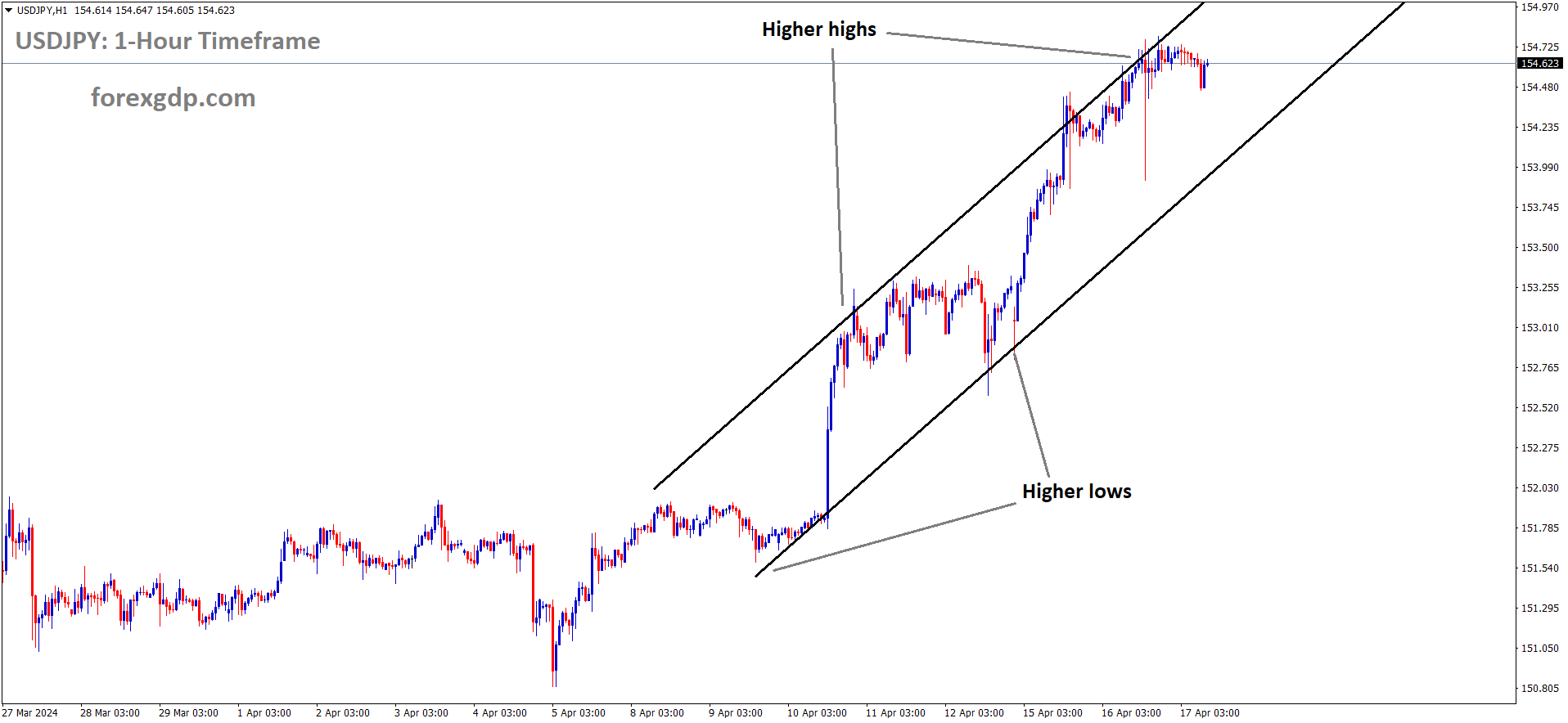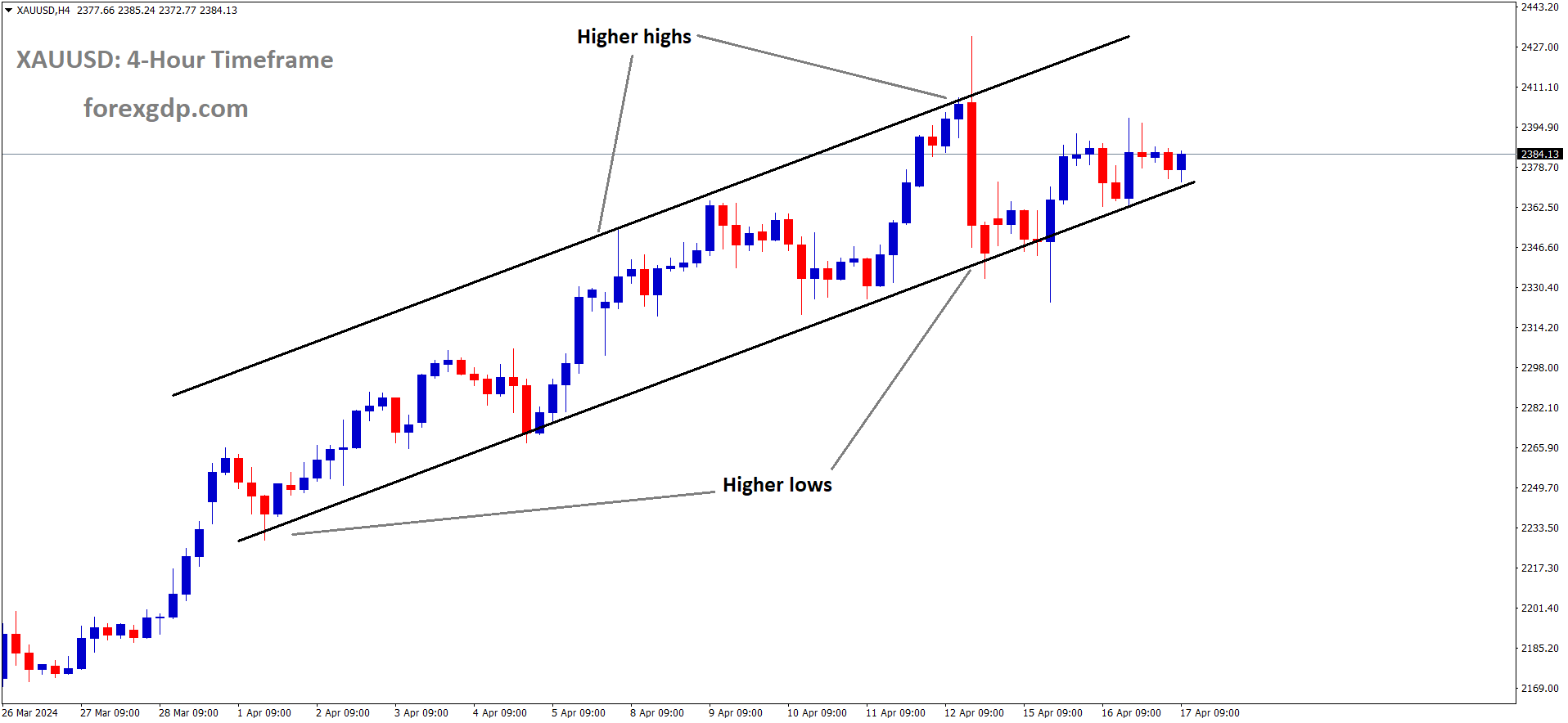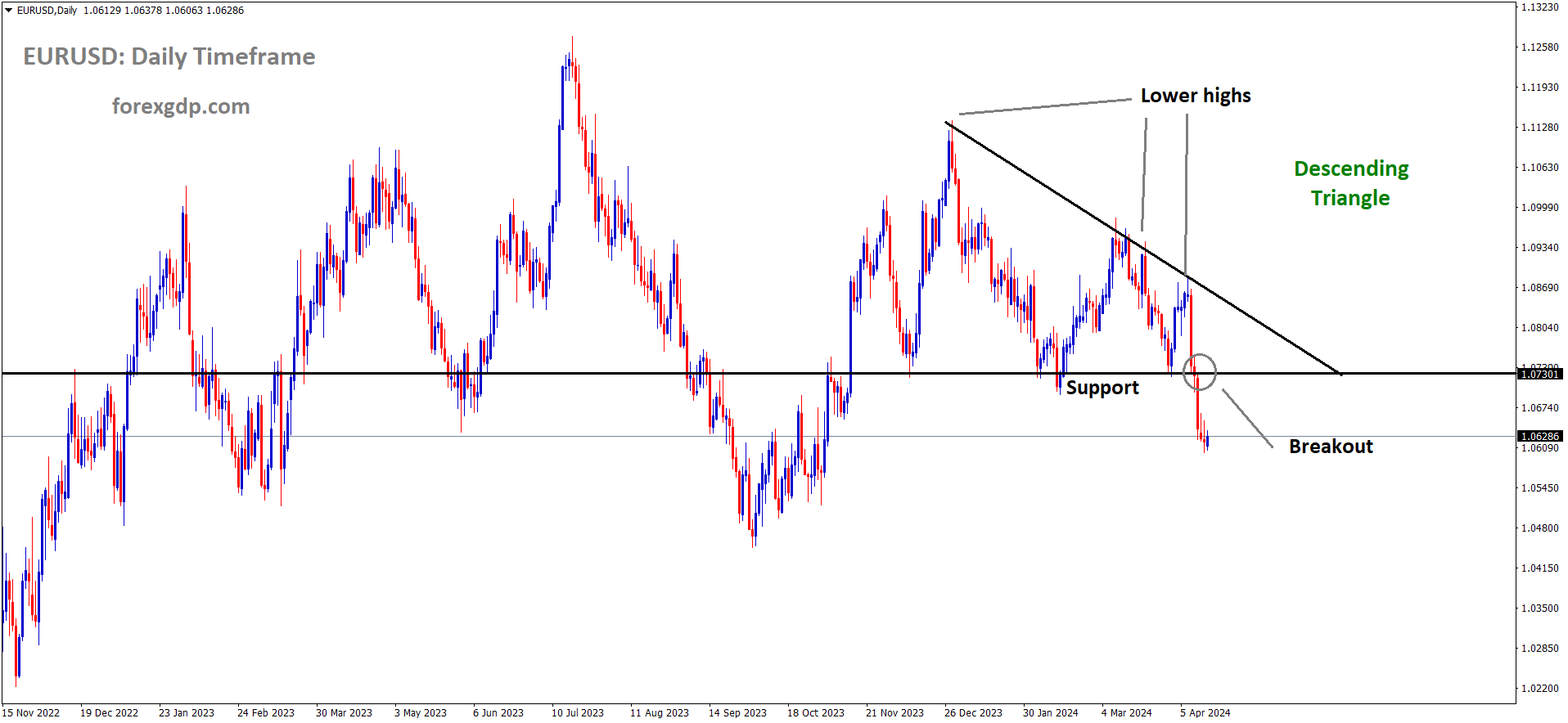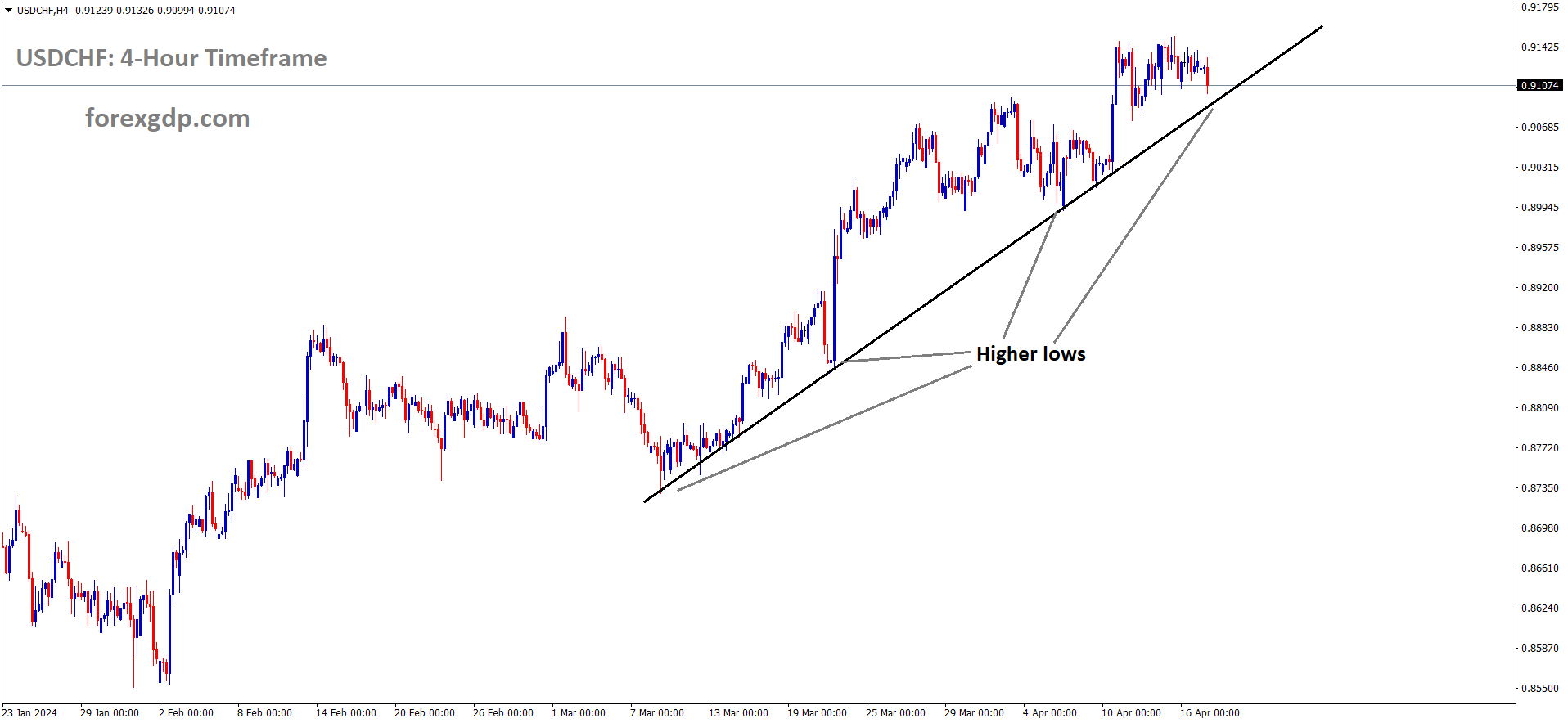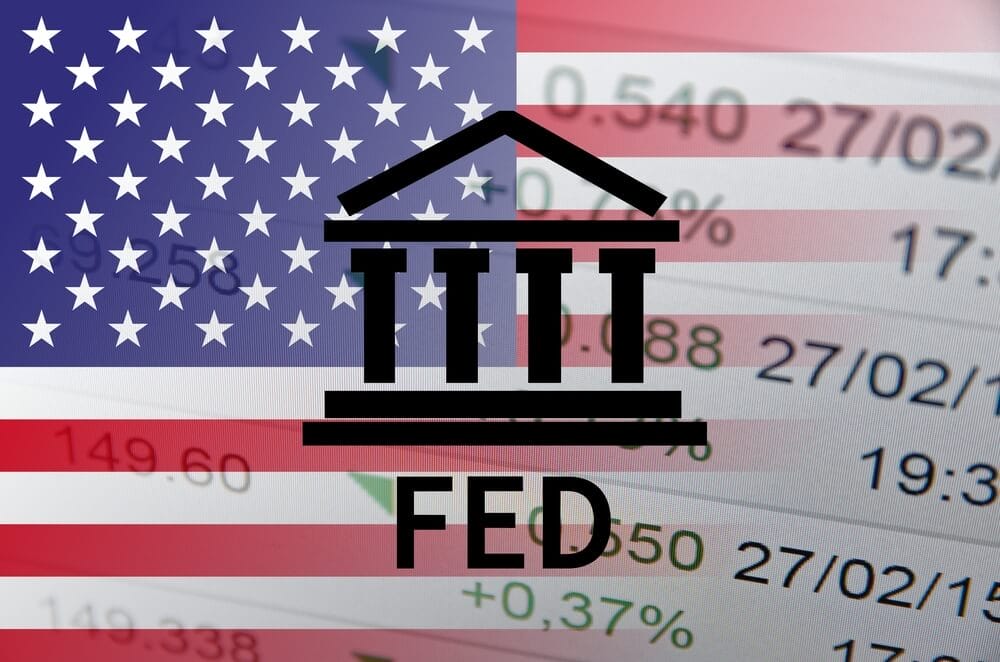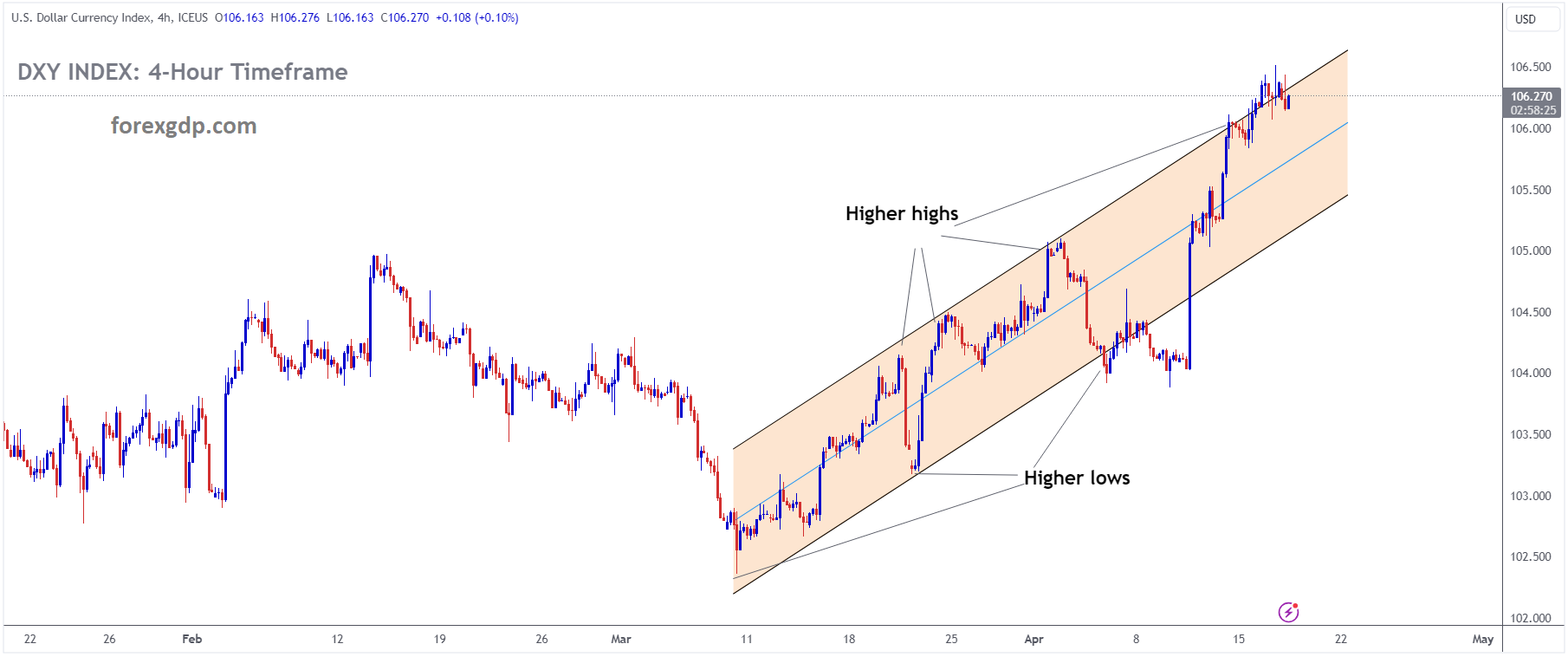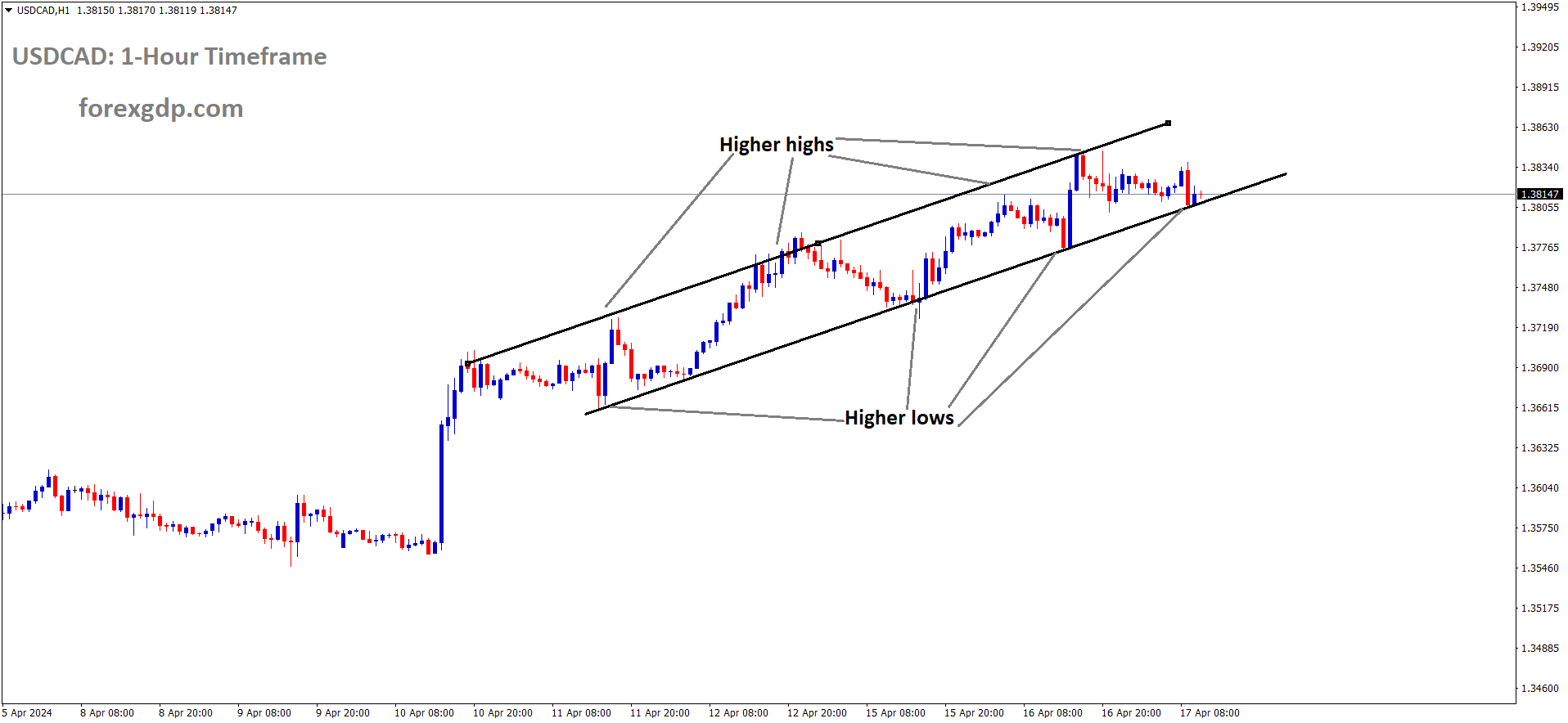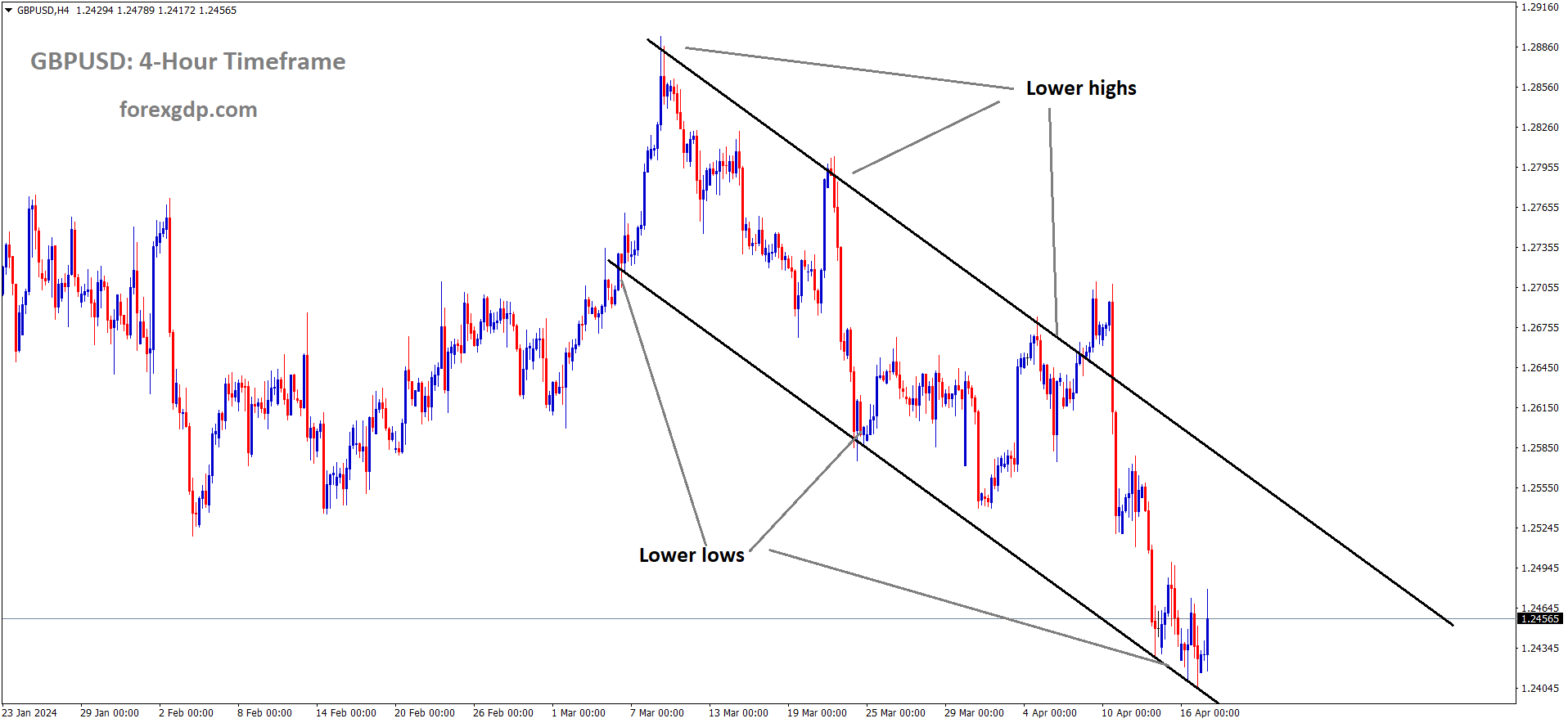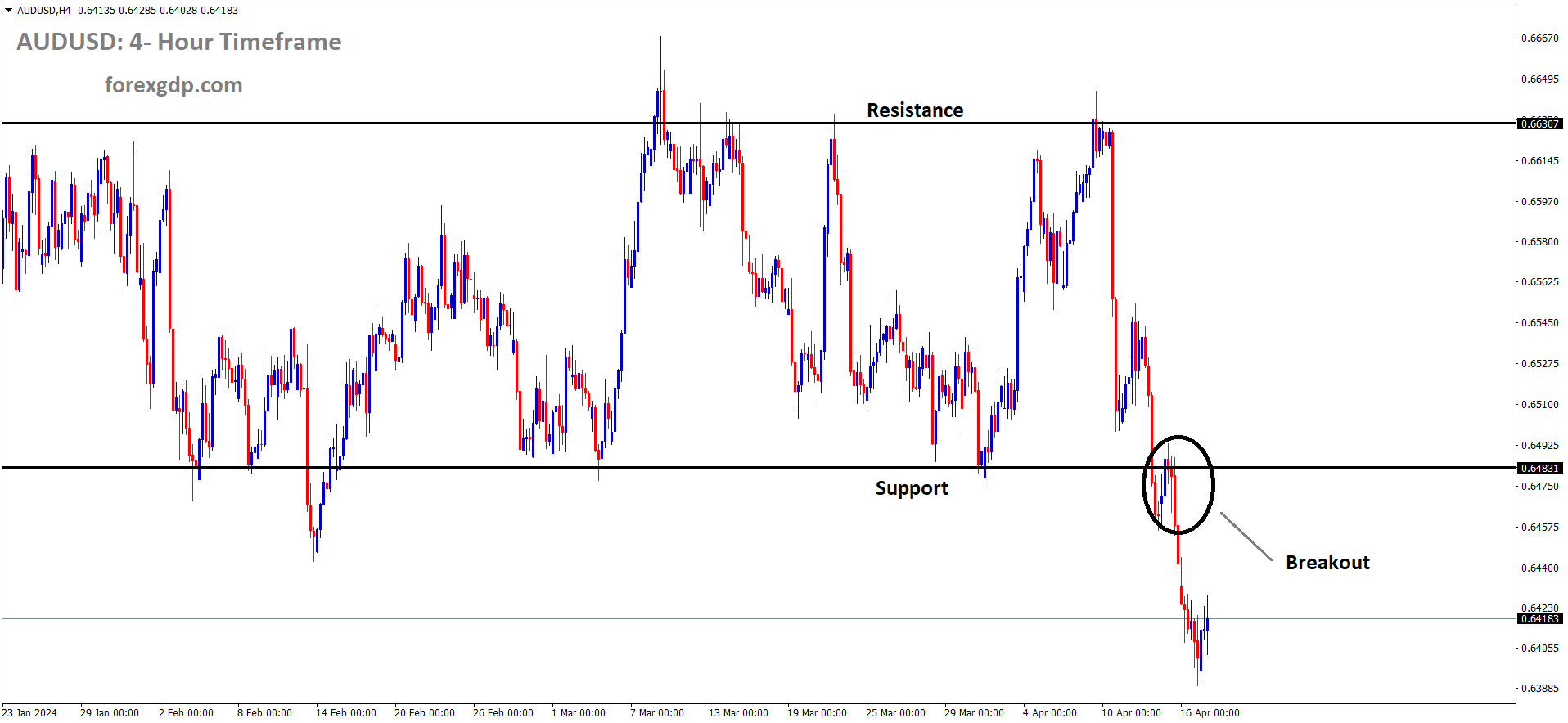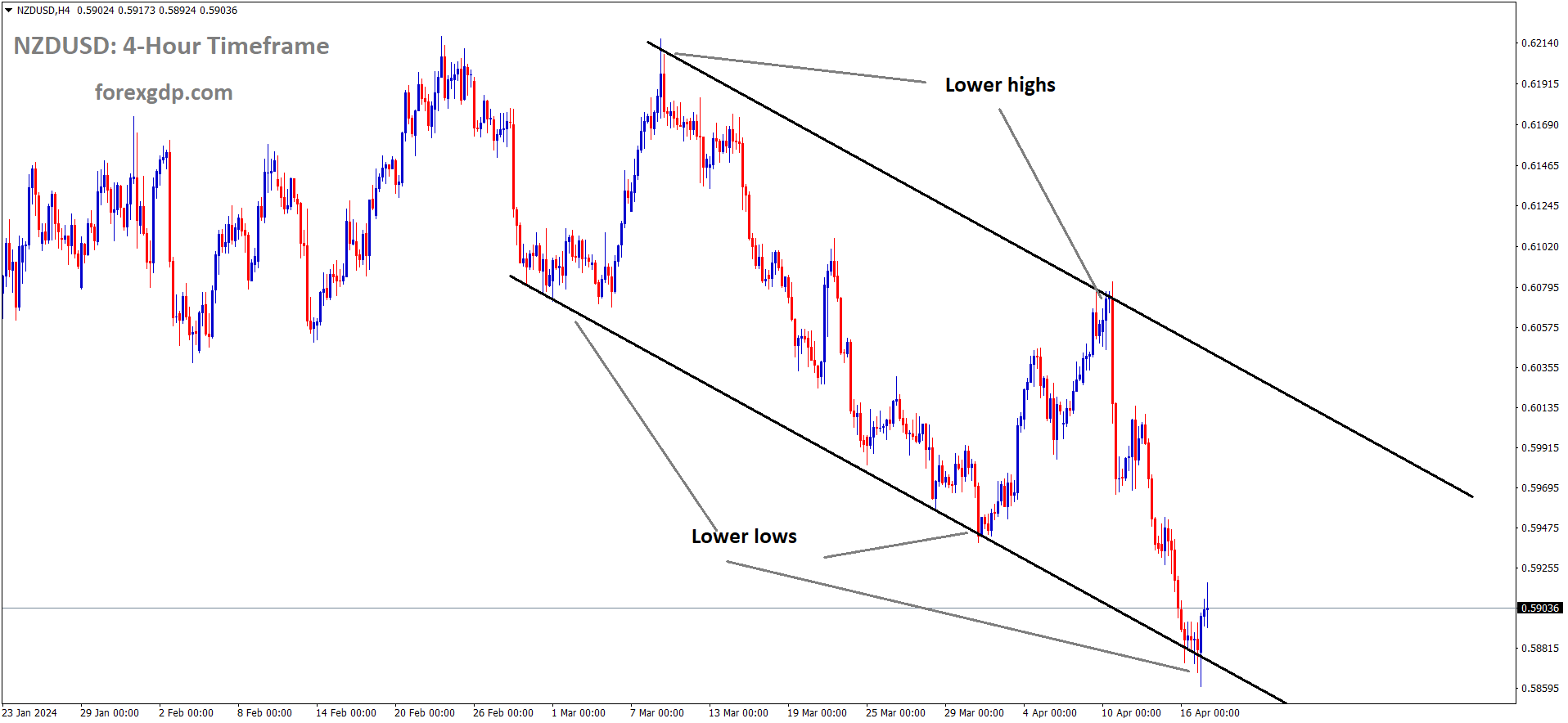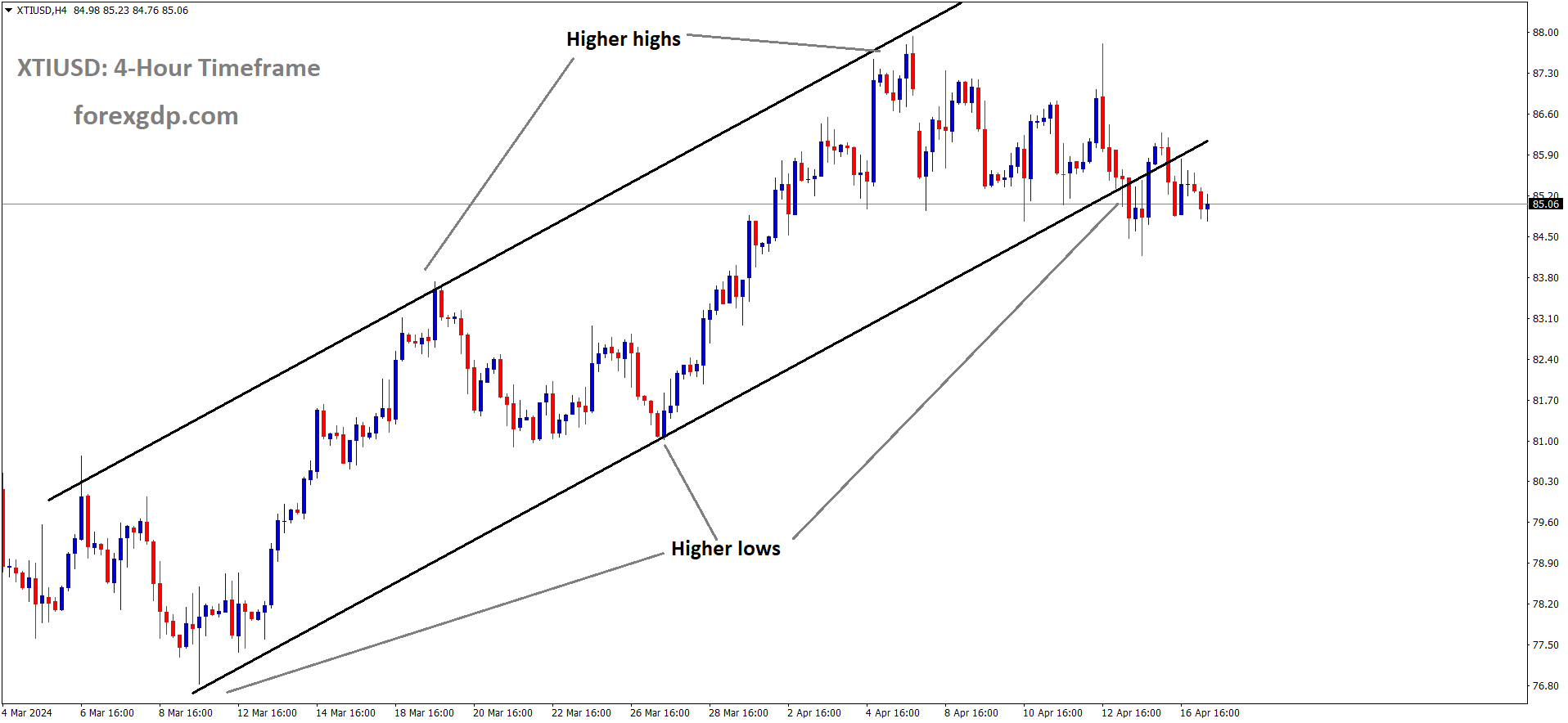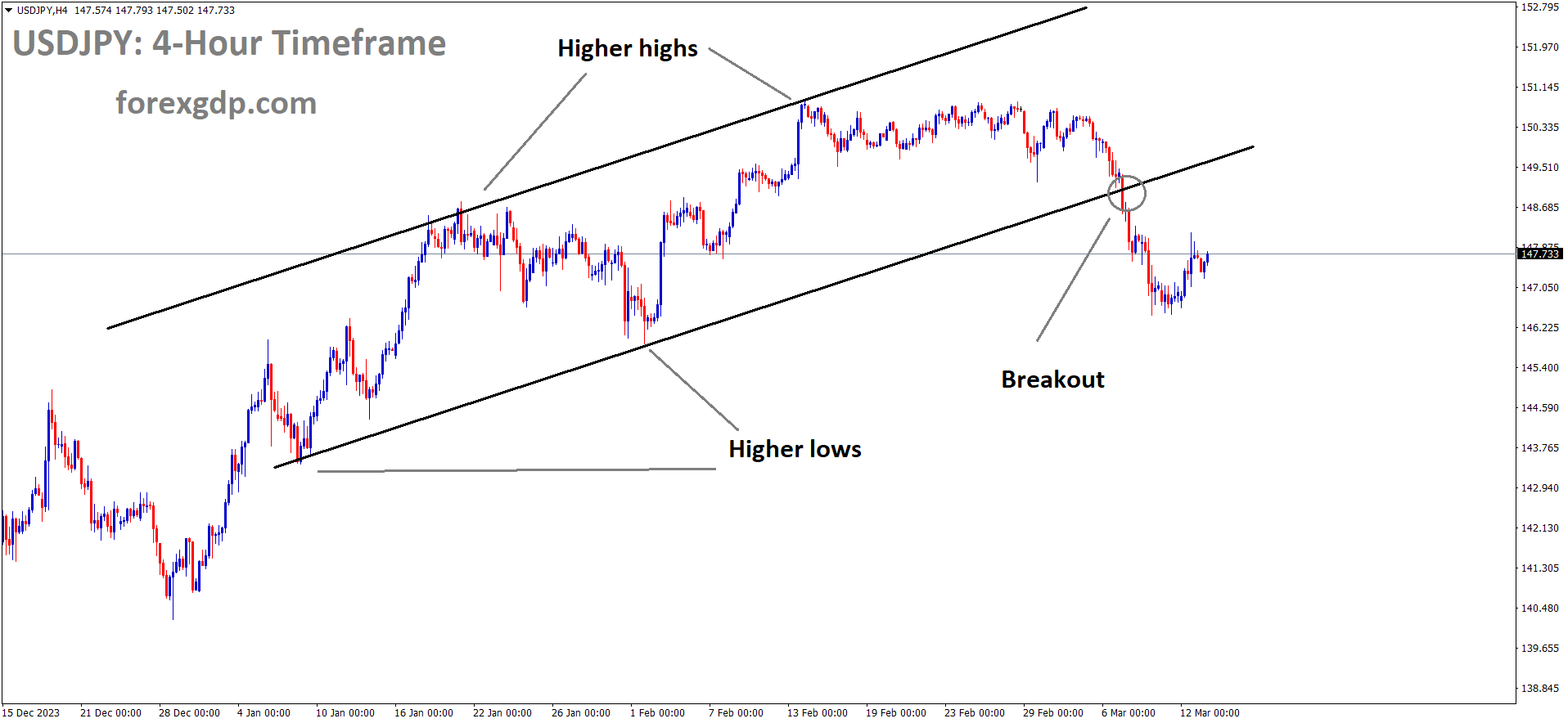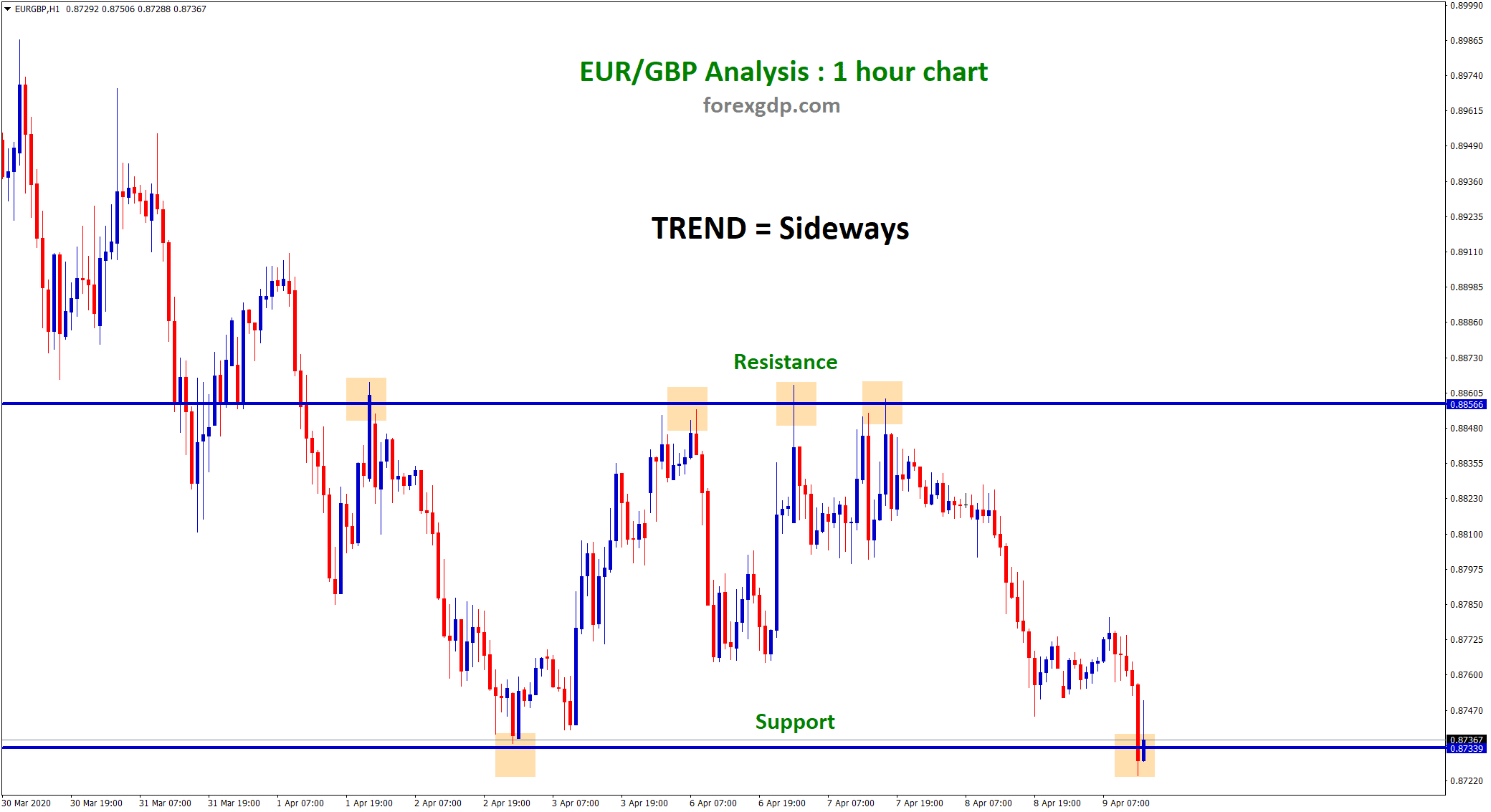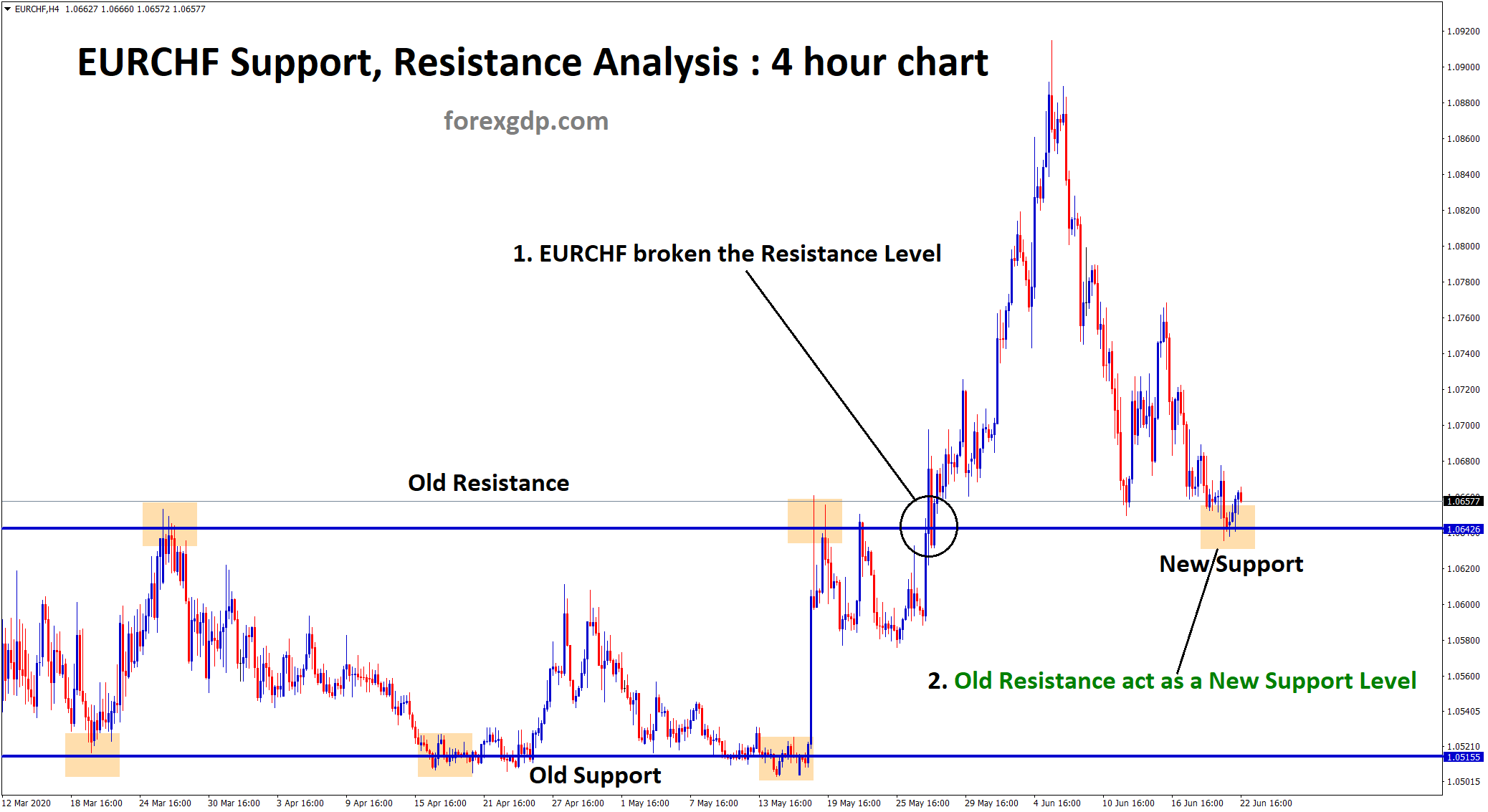USDJPY is moving in an Ascending channel and the market has fallen from the higher high area of the channel
USDJPY – Nears its June 1990 peak above 154.50
The Japanese Yen moved lower against USD and USDJPY reached 1990 year level as 154.50 in the market. Japan Trade surplus March month improved to Yen 366.5 Billion from Yen 377.5 Billion in the previous month. Japan Manufacturers have a more confidence on Japan economy due to weakness of Japan Yen in the Foreign market.
USD/JPY is currently trading around 154.60 during the early European session on Wednesday, maintaining proximity to its peak at 154.78, a level not reached since June 1990. The pair’s movement is influenced by a variety of factors, including a slight downward correction in the US Dollar (USD) and Japan’s economic indicators.
The US Dollar’s performance against the Japanese Yen faces some pressure from a minor correction in its value. However, expectations of the Federal Reserve (Fed) maintaining interest rates at elevated levels for an extended period offer support to the USD/JPY pair. This outlook is fueled by the strength of the US economy and persisting inflation, as highlighted by Federal Reserve Chair Jerome Powell’s recent remarks at the Washington Forum. Powell’s comments suggested that progress toward the 2% inflation target may take longer than initially anticipated, contributing to a more hawkish stance and reinforcing the US Dollar.
Conversely, the Japanese Yen finds some support from Japan’s economic indicators. The country’s trade balance swung to a surplus in March, with the Merchandise Trade Balance Total improving to ¥366.5 billion from the previous deficit. Additionally, sentiment among Japanese manufacturers softened in April due to a weaker Yen, which drove up import expenses.
Furthermore, the Japanese Yen may benefit from safe-haven inflows amid prevailing risk aversion in the market. Investors are closely monitoring developments related to Israel’s response to Iran’s recent air strike, which could potentially escalate tensions in the Middle East.
Traders are eagerly anticipating the release of Japan’s National Consumer Price Index (CPI) data by the Statistics Bureau of Japan on Friday. Market expectations suggest a moderation in Consumer Prices for March, which could further influence the direction of the USD/JPY pair.
XAUUSD – Gold Edges Up, Falls Short of $2,400 Amid Fed’s Hawkish Comments
The Gold prices are remaining higher after the US Strong domestic data. US Housing starts dropped to 14.7% in March month and Building permits declined to 4.3%. FED said industrial production in the march month is stable and US Retail sales printed at higher numbers this week.
XAUUSD Gold price is moving in an Ascending channel and the market has rebounded from the higher low area of the channel
Gold experienced a slight uptick late in Tuesday’s North American session, rising by 0.22% following a hawkish stance from Federal Reserve Chair Jerome Powell. Despite mixed economic data from the United States (US), including Monday’s Retail Sales report, Powell’s remarks kept US Treasury yields elevated, limiting the precious metal’s upward momentum.
As of the latest update, XAU/USD is trading at $2,388 after touching a daily low of $2,363. Heightened tensions in the Middle East have dampened risk appetite, with Iran’s recent attack on Israel prompting anticipation of retaliation, despite warnings from the White House against involvement.
Given the prevailing geopolitical backdrop, Gold is poised to continue its upward trajectory, especially after Powell’s acknowledgment of the strong performance of the US economy alongside the lack of significant progress on inflation in recent data.
Following Powell’s remarks, market sentiment regarding rate cuts by the Federal Reserve has tempered. According to Reuters, expectations for multiple rate cuts this year have diminished, with the first potential cut now forecasted for September, carrying odds of 71.38% for a quarter-percentage-point reduction.
In terms of economic indicators, March saw a decrease in US Building Permits by 4.3%, falling below expectations at 1.458 million. Housing Starts also experienced a notable decline of 14.7%, dropping to 1.321 million, well below the forecasted 1.48 million. However, March’s Industrial Production remained stable, meeting estimates and maintaining the previous month’s growth rate of 0.4% month-on-month (MoM).
Despite mixed economic signals, attention remains on robust March US Retail Sales data released on Monday, particularly the performance of the control group, which significantly surpassed forecasts and previous results, crucial for GDP calculations.
However, geopolitical risks are at the forefront, with reports suggesting that Israel has finalized plans for a counterstrike against Iran, as revealed by The Jerusalem Post.
Gold’s resilience is notable despite the climb in US Treasury yields, particularly in the belly and long end of the yield curve. The US Dollar Index (DXY) has also strengthened, gaining 0.11% to 106.29, reaching levels last seen in November 2023.
Additionally, GDP estimates for Q1 2024 indicate an expected growth rate of 2.9% for the US economy, up from the 2.8% estimated on April 15, as per the Atlanta GDP Now model.
EURUSD – In 1.0600s Oversold Before Eurozone Inflation Data
The Euro zone inflation for the month of March is expected to 2.4% from 2.6% printed in the last month. Core CPI data is expected at 2.9% from 3.1% in the February month. ECB members said there will be a rate cuts in the June month and based on Middle east tensions we do proper policy settings in the economy.
EURUSD has broken the Descending triangle pattern in downside
EUR/USD is experiencing a slight downturn on Wednesday, trading in the lower 1.0600s and marking its sixth consecutive day of losses. The pair’s movement is notable as it enters the oversold zone on charts, indicating a cautious approach among traders. While this doesn’t guarantee an immediate reversal of the downtrend, it suggests the possibility of an upward correction in the near future.
The main focal points for EUR/USD today revolve around the final Eurozone inflation readings and speeches by European Central Bank (ECB) officials.
Eurozone March inflation data, particularly the final estimates, scheduled for release at 9:00 GMT, could introduce volatility to EUR/USD trading. Inflation figures influence ECB decisions on interest rates, a pivotal factor in FX markets. Any discrepancies in the final estimates compared to initial projections may prompt fluctuations in the currency pair.
Flash estimates for March’s Harmonized Index of Consumer Prices (HICP) showed a 2.4% year-on-year increase, slightly down from the previous 2.6%. Expectations for the final estimate remain at 2.4%. Similarly, the flash estimate for Core HICP indicated a 2.9% year-on-year rise, down from 3.1% previously. Any revisions to these figures could impact EUR/USD movement.
A lower-than-expected final inflation estimate might reinforce expectations of an imminent interest rate cut by the ECB, likely in June, potentially leading to a depreciation of the Euro and a decline in EUR/USD. Conversely, an upward revision in HICP figures could cast doubt on the necessity of a rate cut, strengthening the Euro and prompting a recovery in EUR/USD.
Furthermore, speeches by key ECB members, including Piero Cipollone, Isabel Schnabel, and President Christine Lagarde, could contribute to the pair’s volatility. Lagarde’s recent remarks hinting at an upcoming rate cut, barring unforeseen circumstances, coupled with concerns over Middle East tensions, have already fueled speculation regarding ECB’s monetary policy adjustments.
USDCHF – Holds above 0.9100 Amid Cautious Mood, Eyes Geopolitical Tensions
The US National Security Advisor Jake Sullivan said US will be impose more sanctions on Iran supported revolutionary groups and Iran Defence ministry due to more problematic behaviors on other countries. This sanctions will degraded the military power of Iran in the coming days. The Western Leaders urged Israel to giveup the retailiation against Iran. Tensions makes USD Stronger against Swiss Franc in the market.
USDCHF is moving in an Ascending channel and the market has reached the higher low area of the channel
Concurrently, ongoing geopolitical tensions in the Middle East continued to bolster the Swiss Franc (CHF), considered a traditional safe-haven currency.
Late Tuesday, National Security Advisor Jake Sullivan announced forthcoming sanctions targeting Iran and entities supporting the Islamic Revolutionary Guard Corps and Iran’s Defense Ministry. These measures aim to exert pressure on Iran’s military capacity and confront its problematic behaviors. Western leaders have urged Israel to exercise restraint amid escalating tensions with Iran. Market participants are closely monitoring developments in the region, as any further escalation could elevate safe-haven assets like CHF and weigh on the USD/CHF pair.
However, the Greenback remains supported by robust US economic data and hawkish comments from the Federal Reserve. Fed Chair Jerome Powell emphasized the need for monetary policy to remain restrictive due to inflation not reaching the 2% target. This stance dampened expectations for rate cuts, boosting the USD against its counterparts. The CME FedWatch Tool indicates a 67% probability of a rate cut in September.
USD Index – Powell: More Time Needed for Restrictive Policy
US FED Chairman Jerome Powell said at Economic trends meeting, US Economy is doing good and robust in all sectors. Wage pressures are higher and Job growth is good. Inflation is not come to our target this year due to current circumstances. So Restrictive monetary policy sustained in this year. Hawkish comments from FED Powell moved US Dollar higher against Counter pairs.
USD Index is moving in an Ascending channel and the market has reached the higher high area of the channel
At the Wilson Center’s Washington Forum in Washington, DC, Federal Reserve (Fed) Chairman Jerome Powell engaged in a fireside chat focusing on economic trends in North America.
Powell highlighted the robust performance of the U.S. economy, emphasizing recent data indicating limited progress on inflation throughout the year. Despite the economy’s strength, he observed a transition in the labor market toward a more favorable equilibrium.
Key Quotes:
– The U.S. performance has been characterized as “quite strong.”
– Recent data suggests a lack of substantial progress on inflation in the current year.
– The labor market is gradually shifting towards a more balanced state despite ongoing economic strength.
– Broader wage pressures are showing signs of gradual moderation.
– Estimates indicate little change in twelve-month core Personal Consumption Expenditures (PCE) inflation as of March.
– The Fed adopted a cautious stance last year, refraining from overreacting to declines; recent data haven’t instilled greater confidence.
– If elevated inflation persists, the Fed is prepared to maintain the current interest rate for as long as necessary.
– Powell underscored that restrictive monetary policy requires additional time to yield its intended effects.
USDCAD – Retreats on Dollar correction, declining oil prices
The USDCAD Moved higher last day after the Canadian CPI came at slight higher than the previous month reading. CPI MoM came at 0.60% in the March versus 0.70% expected and 0.30% printed in the previous month. YoY data came at 2.9% versus 2.8% printed in last month. Core CPI data came at 2.0% MoM versus 2.1% in the previous month, YoY data came at 0.50% versus 0.10% printed last month.
USDCAD is moving in an Ascending channel and the market has reached the higher low area of the channel
The USD/CAD pair experiences a mild retreat as the US Dollar (USD) corrects slightly, exerting downward pressure. However, the Canadian Dollar (CAD) faces its own challenges with lower crude oil prices, which could limit the pair’s losses.
In Canada, recent inflation figures provide support for potential easing of borrowing conditions by the Bank of Canada (BoC) in its upcoming June meeting. The Consumer Price Index (CPI) for March rose by 0.6% month-over-month, slightly below expectations of 0.7%, but higher than the previous increase of 0.3%. Year-over-year (YoY) CPI also saw a rise to 2.9% from the previous 2.8%. However, Core CPI, a closely monitored measure, showed signs of easing, with a YoY increase of 2.0% compared to the previous 2.1%. Despite this, the monthly Core index rose by 0.5%, surpassing the previous 0.1%.
Conversely, hawkish comments from Federal Reserve (Fed) officials and the attraction of safe-haven flows may bolster the US Dollar (USD), potentially limiting the downside for the USD/CAD pair. The US Dollar Index (DXY) retreats from a recent five-month high of 106.51, partially due to a slight decline in US Treasury yields.
Fed Chair Jerome Powell’s remarks on Tuesday underscore the US economy’s robustness but also express concern about inflation progress. Powell suggested that reaching the 2% inflation target might take longer than anticipated, signaling a hawkish stance that could support the US Dollar.
GBPUSD – Pound Surges on UK Inflation Beat
UK CPI Data for the month of March came at 3.2% versus 3.1% expected and 3.4% printed in the previous reading. Core CPI came at 4.2% from 4.5% in the previous month and 4.1% is expected. BoE measured target of 2% is higher than current reading, So GBP Moved higher against counter pairs.
GBPUSD is moving in the Descending channel and the market has reached the lower low area of the channel
Pound Sterling Rebounds on Robust UK Inflation Report
The Pound Sterling (GBP) sees a significant surge during Wednesday’s trading session in London following the release of stronger-than-anticipated inflation data by the United Kingdom’s Office for National Statistics (ONS). The Consumer Price Index (CPI) for March surpassed economists’ forecasts, indicating a higher-than-expected increase in consumer prices. Despite this beat, the inflation rate has softened compared to February, suggesting that the Bank of England’s (BoE) recent interest rate hikes are helping to alleviate inflationary pressures.
Additionally, producer price inflation has exhibited a slowdown, indicating that prices of goods and services at factory gates are experiencing a decrease. This trend often occurs when businesses anticipate subdued demand, prompting them to lower prices.
The slightly elevated inflation figures may cast doubt on market expectations of a rate cut by the BoE in November. However, recent employment data released on Tuesday suggested a cooling in the UK job market. The unemployment rate surged to 4.2% in the three months ending February, exceeding expectations and indicating a decline in employment by 156,000 during the same period.
Market Overview:
– Pound Sterling strengthens to 1.2460 following the release of the UK’s higher-than-expected inflation figures for March.
– Annual headline inflation rises to 3.2%, surpassing expectations, but showing a deceleration from the previous reading of 3.4%.
– Monthly headline inflation shows steady growth of 0.6%.
– Annual core CPI, excluding volatile food and energy prices, increases to 4.2%, slightly higher than expected, but significantly lower than February’s reading of 4.5%.
– March’s inflation data is unlikely to alter market speculation regarding potential BoE rate cuts, currently anticipated for November.
– Global market sentiment remains subdued due to escalating tensions in the Middle East and hawkish interest rate guidance from Federal Reserve Chair Jerome Powell.
– S&P 500 futures indicate losses amid fears of further escalation in Iran-Israel tensions, with Israel vowing retaliation against Iran’s recent attack.
– The US Dollar Index (DXY) maintains near a five-month high around 106.40, with expectations of further upside following Powell’s remarks emphasizing the need for sustained higher interest rates amidst strong labor demand and sluggish inflation progress towards the desired 2% target.
AUDUSD – AUD trims gains as USD strengthens; Fed’s Beige Book awaited
The Australian Dollar moved down after the Middle east tensions rising up. US warned Iran for imposing more sanctions, Israel is setting points in Iran for counter attack on Sunday. Westpac leading index came down to 0.80% in the March month compared to 1.6% increase in February month.
AUDUSD has broken the Box pattern in downside
The Australian Dollar (AUD) showed signs of recovery on Wednesday after a three-day decline, although it faced resistance due to the US Dollar’s (USD) strength fueled by hawkish remarks from Federal Reserve (Fed) officials. At the same time, investors awaited Israel’s response to Iran’s recent air strike cautiously, which contributed to risk aversion in the market.
The rebound in the Australian Dollar coincided with the ASX 200 Index bouncing back from three consecutive days of losses. However, concerns about escalating tensions between Israel and Iran tempered investor sentiment, leading to cautious trading.
The US Dollar Index (DXY) retreated from its recent five-month high amid a slight decline in US Treasury yields. Fed Chair Jerome Powell’s comments on Tuesday, indicating slower progress on inflation than anticipated, contributed to a hawkish stance and provided support to the US Dollar.
In other news, Westpac Leading Index for March declined by 0.1%, China’s GDP for the first quarter of 2024 exceeded expectations, and the US announced plans for new sanctions targeting Iran.
Federal Reserve Bank of San Francisco President Mary Daly emphasized the need for further progress on inflation before making any decisions. The likelihood of interest rates remaining unchanged in the June meeting increased to 84.8% according to the CME FedWatch Tool.
US economic data showed mixed results, with Building Permits and Housing Starts falling short of expectations, while Retail Sales exceeded forecasts.
The Australian Employment Change and Unemployment Rate data for March are scheduled for release on Thursday, adding to market anticipation.
NZDUSD – New Zealand Q1 CPI Inflation Beats Expectations
NZ CPI Data QoQ came at 0.60% to the March 2023 and above the previous reading of 0.50%. Annualised reading came at 4.0% compared to 4.70% in the previous month. NZ Dollar moved up after the reading came.
NZDUSD is moving in the Descending channel and the market has reached the lower low area of the channel
According to Statistics New Zealand’s report released on Wednesday, inflation in New Zealand, measured by the change in the Consumer Price Index (CPI), increased to 0.6% quarter-on-quarter (QoQ) in the first quarter (Q1) of 2024, up from 0.5% in the preceding reading. This figure aligned with market expectations, as analysts had anticipated a 0.6% increase.
Furthermore, the annualized CPI inflation rate in New Zealand for the same period stood at 4.0% year-on-year (YoY), compared to the previous period’s figure of 4.7%.
CRUDE OIL – WTI Below $84.50 Despite Geopolitical Risks
The Crude Oil prices are lowered after the US Energy reserves said 4.03 million Barrels in reserves on April 12 ending from 3.03 million Barrels reserves in the previous week. So Oil reserves are higher during middle east tensions makes Oil prices moving in the flat regions.
XTIUSD Oil price is moving in an Ascending channel and the market has reached the higher low area of the channel
Western Texas Intermediate (WTI), the US crude oil benchmark, is trading around $84.25 on Wednesday. The black gold edges lower on the day as hawkish comments from Federal Reserve (Fed) Chairman Jerome Powell offset the escalating geopolitical tensions in the Middle East.
Investors place lower bets on the Fed rate cuts this year as the US economy remains robust and inflation is still elevated. The Fed Chair Jerome Powell said Tuesday that it will take “longer than expected” to achieve the confidence needed to bring inflation to the central bank’s 2% target. It’s worth noting that the higher-for-longer US interest rate narrative may put some selling pressure on WTI prices since it translates to less demand for oil as the cost of holding crude oil rises.
Furthermore, Crude oil stockpiles in the United States for the week ending April 12 increased by 4.09 million barrels from a build of 3.03 million barrels in the previous week. The market consensus estimated that stocks would rise by about 600,000 barrels, according to the American Petroleum Institute on Tuesday.
The ongoing geopolitical tension in the Middle East continues to boost WTI prices. National Security Advisor Jake Sullivan said in a statement late Tuesday that new sanctions targeting Iran and sanctions against entities supporting the Islamic Revolutionary Guard Corps and Iran’s Defense Ministry will be imposed in the coming days. In case of further escalation, $100 oil is possible, Citigroup analysts said.
Apart from this, China’s crude oil imports reached a new high in 2023, jumping by 10% YoY and shattering the previous record set in 2020. This benefits black gold, as China is the world’s largest crude oil importer.
Don’t trade all the time, trade forex only at the confirmed trade setups
Get more confirmed trade signals at premium or supreme – Click here to get more signals , 2200%, 800% growth in Real Live USD trading account of our users – click here to see , or If you want to get FREE Trial signals, You can Join FREE Signals Now!

